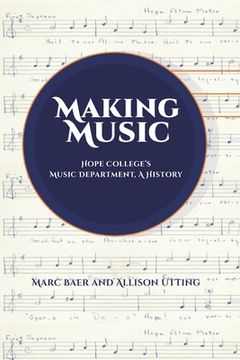Reseña del libro "Making Music: Hope College's Music Department, A History (en Inglés)"
On October 22, 2015, the Jack H. Miller Center for Musical Arts opened on the east side of Hope's campus, and at that time, the college's Department of Music comprised thirteen full-time and twenty-eight part-time faculty. Such a remarkable building and staff could not have been imagined in 1862 when the college opened its doors to a handful of students.There has always been music at Hope College. Indeed, making music has been so pervasive, it is a wonder that Hope students have had time to do anything else. But if, as in the words of the student newspaper, "We find music everywhere," then in the early years, it was also nowhere, at least in terms of either having a recognized physical space or being an established part of the college curriculum-or even having the appropriate faculty for such an academic department. John Nykerk is traditionally considered the founder of Hope College's Department of Music. Although it is true that Nykerk shaped what would become a department to fit a modern form, it is equally true that the department's foundation goes back to the first days of the college, because music has always been taught at Hope-even before the college graduated its first class. If music has existed from the beginning, then as historians, we want to point out how much context matters, because we often err by imposing our own experience onto the past. Thus, the music at Hope College has changed, just as the college has changed-music has served a changing Hope, and Hope has served a changing Music Department. Music made the department, not the other way around. To unpack all this, we approach various topics through six thematic chapters.The first chapter tells the convoluted story of the era between the 1860s and the 1940s, when the college did not know quite what to do with music. Read any Anchor before the last few decades, and notice that the subject of music dominates its pages. But should the model of teaching music to students be that of the conservatory or the liberal arts college? To justify the major required a definition of Music's identity, that is, should the music taught to students have the academic rigor of philosophy or chemistry, or was it better to think first in terms of what today would be termed an extracurricular?If the story in the first chapter is complicated, then that of the second chapter is relatively simple: a recognizably modern faculty with a distinct character emerged fairly quickly from around 1945 to 1965, due to a strong working relationship and respect between the leadership of the department and that of the college. Yet from the late 1860s to the early 1890s, the outcome of that relationship could not be predicted.Chapter 3 focuses on students as makers of music. To a large extent, this story is told through the eyes of the department. Students, however, have made music on their own in venues far beyond the department, for example, a class party after the Pull or fraternity men serenading the women of Voorhees-who then did their own spontaneous singing.One of the most intriguing questions from the late nineteenth through the late twentieth century involved physical location. Almost every department at Hope had a well-recognized building associated with it. For Music, however, it proved hard to determine where home was for the faculty who taught music and if there could be an appropriate building in which all musicians could both teach and perform. It is safe to say that by 2015 musical performances ranked second in terms of audience, just after collegiate athletics. At the same time, what those audiences heard in the century and a half covered in this book was characterized by both change and continuity. Although audiences from 1866 to the present have heard music at Hope College-graduation being a case-different years have brought different kinds of music. Musical events at Hope are the bridge that links the college to the city of Holland-and beyond.

